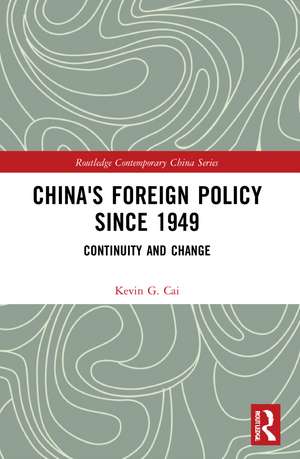China's Foreign Policy since 1949: Routledge Contemporary China Series
Autor Kevin G. Caien Limba Engleză Paperback – 25 ian 2022
Din seria Routledge Contemporary China Series
-
 Preț: 326.21 lei
Preț: 326.21 lei -
 Preț: 339.65 lei
Preț: 339.65 lei -
 Preț: 311.41 lei
Preț: 311.41 lei -
 Preț: 280.32 lei
Preț: 280.32 lei -
 Preț: 317.85 lei
Preț: 317.85 lei -
 Preț: 350.12 lei
Preț: 350.12 lei - 18%
 Preț: 1059.45 lei
Preț: 1059.45 lei - 28%
 Preț: 848.57 lei
Preț: 848.57 lei - 18%
 Preț: 1223.21 lei
Preț: 1223.21 lei - 18%
 Preț: 1060.74 lei
Preț: 1060.74 lei -
 Preț: 422.90 lei
Preț: 422.90 lei - 18%
 Preț: 954.20 lei
Preț: 954.20 lei - 18%
 Preț: 1169.66 lei
Preț: 1169.66 lei - 18%
 Preț: 1049.84 lei
Preț: 1049.84 lei - 18%
 Preț: 1217.95 lei
Preț: 1217.95 lei - 18%
 Preț: 1222.16 lei
Preț: 1222.16 lei - 28%
 Preț: 823.99 lei
Preț: 823.99 lei - 18%
 Preț: 1061.93 lei
Preț: 1061.93 lei - 18%
 Preț: 1057.89 lei
Preț: 1057.89 lei - 18%
 Preț: 1112.03 lei
Preț: 1112.03 lei - 18%
 Preț: 1008.02 lei
Preț: 1008.02 lei -
 Preț: 416.82 lei
Preț: 416.82 lei - 25%
 Preț: 823.99 lei
Preț: 823.99 lei - 18%
 Preț: 1114.70 lei
Preț: 1114.70 lei - 15%
 Preț: 702.39 lei
Preț: 702.39 lei - 28%
 Preț: 526.88 lei
Preț: 526.88 lei - 18%
 Preț: 712.13 lei
Preț: 712.13 lei - 18%
 Preț: 1065.06 lei
Preț: 1065.06 lei - 18%
 Preț: 703.09 lei
Preț: 703.09 lei - 18%
 Preț: 1060.87 lei
Preț: 1060.87 lei - 18%
 Preț: 1057.89 lei
Preț: 1057.89 lei - 18%
 Preț: 1062.98 lei
Preț: 1062.98 lei - 18%
 Preț: 1222.16 lei
Preț: 1222.16 lei - 18%
 Preț: 1055.51 lei
Preț: 1055.51 lei -
 Preț: 413.55 lei
Preț: 413.55 lei - 18%
 Preț: 1001.84 lei
Preț: 1001.84 lei -
 Preț: 386.57 lei
Preț: 386.57 lei - 18%
 Preț: 1055.38 lei
Preț: 1055.38 lei - 18%
 Preț: 1053.95 lei
Preț: 1053.95 lei - 18%
 Preț: 1061.57 lei
Preț: 1061.57 lei - 18%
 Preț: 1058.79 lei
Preț: 1058.79 lei - 18%
 Preț: 1109.18 lei
Preț: 1109.18 lei - 18%
 Preț: 1053.47 lei
Preț: 1053.47 lei - 18%
 Preț: 1053.16 lei
Preț: 1053.16 lei - 18%
 Preț: 728.24 lei
Preț: 728.24 lei - 18%
 Preț: 1055.38 lei
Preț: 1055.38 lei - 18%
 Preț: 1165.87 lei
Preț: 1165.87 lei - 18%
 Preț: 1227.38 lei
Preț: 1227.38 lei - 15%
 Preț: 701.45 lei
Preț: 701.45 lei
Preț: 386.99 lei
Nou
74.06€ • 80.42$ • 62.21£
Carte tipărită la comandă
Livrare economică 22 aprilie-06 mai
Specificații
ISBN-10: 1032140704
Pagini: 272
Ilustrații: 11 Tables, black and white; 2 Line drawings, black and white; 2 Illustrations, black and white
Dimensiuni: 156 x 234 x 15 mm
Greutate: 0.39 kg
Ediția:1
Editura: Taylor & Francis
Colecția Routledge
Seria Routledge Contemporary China Series
Locul publicării:Oxford, United Kingdom
Cuprins
Recenzii
Robert Sutter, Professor of Practice of International Affairs, George Washington University
Kevin G. Cai’s China’s Foreign Policy since 1949: Continuity and Change is a timely and valuable contribution at a critical juncture of relations between the country and the outside world. Especially valuable are Cai’s illuminations of the process of foreign policy making in China, the evolution of its national security strategy, and Beijing’s exercise of its multi-dimensional power to advance and expand its global interests. Students and analysts of contemporary China will benefit immensely from Cai’s insights and knowledge.
Minxin Pei, Claremont McKenna College
Understanding the origins, content and future of China's foreign policy has never been more important. In this important book, Kevin G. Cai provides us with not just the conceptual building blocks, but also the substantive content to allow us to understand China's relations with the world as they unfold over the next decades. It serves as an invaluable tool for scholars, students and policy-makers alike.
Margaret M. Pearson, Dr. Horace V. and Wilma E. Harrison Distinguished Professor, University of Maryland
Notă biografică
Descriere
This book provides a systematic and comprehensive analysis and overview of China’s foreign policy since 1949. It starts with constructing an analytical framework for explaining Chinese foreign policy and then, on the basis of that, outlines and analyzes developments in different areas of foreign policy – such as security policy, international economic policy and policy toward multilateralism – and foreign policy toward different areas of the world – such as the United States, East Asia, Europe and developing countries. The book also examines decision-making in Chinese foreign policy, discusses issues of current concern, including maritime disputes, Xi Jinping’s more assertive approach to foreign policy, the One Belt One Road initiative and the trade war with the United States. The book concludes with a comparative analysis of the three phases of China’s foreign policy since 1949 and provides a brief assessment of how China’s foreign policy is likely to develop going forward.
